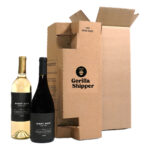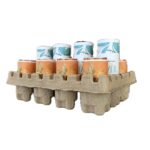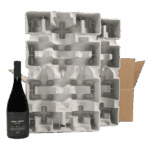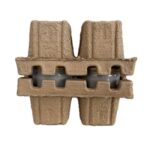How to Package Wine for Shipping
Most people think of packing wine bottles as a necessary inconvenience. It’s something you have to do to protect your products and get them from point A to point B intact. Sounds simple, right? Nope. There’s more to it than that!
Incorrectly packed wine bottles could break during transport and lead to unhappy customers plus costly replacements. In this post, we’ll share how to package wine bottles for shipping so your products can withstand turbulent transit conditions. If you want to learn how to prepare wine bottles for shipment like a pro, keep reading!
1. Use Sturdy Corrugated Boxes
When packing wine bottles, you must use a sturdy box to protect your products from being damaged during transport. A corrugated box is ideal for shipping fragile items, as it is durable and reliable.
The difference between ordinary and corrugated boxes lies in the double wall construction that provides extra insulation and protection. Inside that construction is a ruffled inner layer that increases strength and decreases flexibility while keeping the overall weight of the container down.
The added protection makes corrugated fiberboard a perfect choice to pack wine while reducing costs. If you need help with how to package wine for shipping, corrugated shipper kits make life easy. The materials used to make them are biodegradable, contain no dyes or bleaches, and are compostable and recyclable.
Corrugated boxes also feature designs that increase safety during transport. Our corrugated Hexabox packaging has intuitive, interlocking tabs and compartments for extra security. Their patented, six-sided design distributes weight more evenly to relieve pressure when improperly handled or stacked on top or beneath other parcels.
2. Pack Wine Bottles Securely with Inserts

To ensure your wine is delivered unscathed, use high-quality inserts to keep the bottles secure. Wine bottles are prone to breakage if they come into contact with each other, shift, or experience drops during transit.
Fortunately, many different inserts work well for packing wine bottles. One of the most common is foam inserts. Styrofoam inserts encase wine bottles snugly to protect them from damage during transit. They come in several shapes and sizes. Most importantly, they maintain a constant temperature inside, preventing wine spoilage.
Another popular type is molded pulp inserts. Pulp inserts absorb impact to prevent bottles from getting damaged. They are form-fitted for a secure, snug fit that minimizes shifting during shipping. Unlike foam inserts, pulp inserts are biodegradable and recyclable. They’re the ideal choice for businesses that want to practice eco-friendly shipping.
While they don’t look as effective as foam and pulp inserts, corrugated inserts provide the same, if not superior, protection. Gorilla Shipper’s Hexabox inserts have passed vibration, compression, and free-fall drop tests (10 drops at 30’’) and are ISTA 6-FEDEX-A test certified. We encourage you to learn how to package wine for shipping with inserts to ensure safe delivery every time.
3. Cushion Bottles with Bubble Wrap or Foam Peanuts
Another effective method of packing wine bottles for safe transit is to use bubble wrap. Bubble wrap provides cushioning and protection from bumps and impacts. The air-filled bubbles absorb shock and prevent the bottles from breaking.
Figuring out how to package wine for shipping is not necessary with bubble wrap. Just wrap your bottles on all sides, tape them tightly, and place them in the box. This lightweight solution is available in several shapes and sizes and makes preparing shipments easy.
Foam peanuts are another reliable option that can stand alone or complement other forms of packaging. You can use them as filler for the interior and insulate any product. For best results, immerse your bubble-wrapped products in foam peanuts for extra cushion and protection.
When packing wine bottles, be sure to fill up any extra space between the items to eliminate shifting and prevent damage. Once the bottles are inside the box, the small pieces of shock-absorbing styrofoam will help stabilize and keep goods separated during transit.
4. Double Box Your Wine Shipments

When considering how to package wine for shipping, use the double-boxing method for extra protection. This involves packing each shipment with two boxes instead of one to maximize shock absorption and prevent the bottles from breaking.
The first box is the outer box and uses filler material to provide a stable environment. The second box houses the wine bottles and inserts to prevent them from moving around and becoming damaged. Double-boxing is a quick and simple method to pack glass bottles safely.
To perform this method, pack the original wine box in a new shipping container that is at least six inches longer, wider, and higher than the original. Fill the bottom of the new shipping container with at least two to three inches of inflatable air pillows, loose-fill peanuts, or bubble wrap, and place your wine box in the center.
Lastly, fill the remaining space with packing material and securely tape the outside.
5. Simulate Unexpected Tilts and Shifts
Testing packaging materials before shipping guarantees the integrity of your wine bottles. The initial step in fortifying your packaging against potential vulnerabilities is to conduct a comprehensive evaluation. Before packing wine bottles, consider incorporating drop tests with substitutes inside the box to gauge the impact resistance of your packaging.
You can perform these tests using a drop tester machine or manually drop the packaged products from varying heights and angles onto a hard surface. Afterward, be meticulous in your inspections, looking for cracks, dents, tears, or punctures that may compromise packaging materials.
Next, subject the packaging to controlled conditions such as vibration tests, which mimic the rigors of rough shipping. These tests monitor movement and noise for signs of damage or shifting. Your cargo will face unpredictable shipping conditions, so simulate potential hazards by vigorously shaking the box.
If this process sounds tedious, it is. As a result, it is best to consider purchasing ISTA 6-FEDEX-A TEST-certified shipping products. Commercial-grade packaging allows you to skip these tests to save time and get your shipments out much faster. The way you pack wine bottles for shipping is a big deal. Never skimp. It could make or break your business.
6. Apply Appropriate Labels for Shipping
Now that your materials have successfully aced the testing phase and you know how to package wine for shipping, you can dive into the labeling step. If you decide to use FedEx shipments, the process is a breeze with the FedEx Ship manager. Simply log in to your account and select SEL 169 if shipping domestically. For international shipping, click on SEL 170.
UPS, on the other hand, requires a specific label that boldly declares the presence of alcoholic beverages, and you must include any state-mandated labels. Now that you know the requirements for each carrier, consider the unpredictable climate conditions your products will encounter during transit. Packing wine bottles is relatively easy, but you must assess the entire journey.
For inclement weather, durable, waterproof labels are the best option. They act as the unsung heroes against the elements and prevent delivery issues. With the appropriate labeling, your wine is ready to go. But before you send it out, take a moment and dig a little deeper. Are you shipping internationally? If so, reassess every detail and check all the boxes for shipping to other countries.
7. Follow Carrier Requirements for Shipping Alcohol

Now that you know how to package wine for shipping, you can seal the box and deliver the package. But can YOU ship alcohol? According to federal and state laws, only licensed businesses can sell alcohol, and a signed contract with a shipping carrier is required to ship alcohol in the United States.
Businesses and licensees must also follow requirements when labeling and packing wine bottles for each shipping company. No alcoholic beverages, including wine, may be shipped through the United States Postal Service (USPS) under any circumstance. While you may have heard that unlicensed individuals pack wine and ship with USPS, it is illegal.
With UPS and FedEx, you must label all packages containing wine with a designated alcoholic beverages shipping label and any other labeling the destination state may require. Shipments of wine must also include a completed UPS Adult Signature Form or FedEx Adult Signature Form, depending on your chosen carrier.
8. Determine Optimal Shipping Conditions and Times
Securing safe passage after packing wine bottles involves a calculated approach to shipping conditions and timing. First on the agenda is a deep dive into the optimal temperature and humidity conditions for transporting wine. These factors directly affect the integrity and quality of your product.
The ideal temperature range for shipping wine is between 50 and 68 degrees Fahrenheit. Therefore, you should monitor prevailing weather conditions when selecting the most suitable shipping method to your destination. Choose an option that aligns with the delicate nature of your precious cargo.
Account for all seasonal variations like below-freezing temperatures or extreme heat that impact wine during transit. Ship strategically and sidestep severe weather forecasts to preserve the integrity and taste of your wine throughout its voyage.
If time is of the essence, expedited shipping can be your trusted ally, minimizing transit time and ensuring freshness upon arrival. Lastly, coordinate with shipping carriers to schedule deliveries when the recipient is ready and eager to receive and inspect their highly anticipated delivery.
Package Your Wine with Gorilla Shippers
When packing wine bottles, you have options that will help you ensure your product arrives in one piece. In this article, we outlined some of the most effective techniques. Whether you choose to pack wine using bubble wrap, foam peanuts, the double box method, or wine shipper kits, following these tips will ensure your wine arrives at its destination in pristine condition.
For questions regarding how to package wine for shipping, look no further than Gorilla Shipper. From foam and pulp inserts to corrugated boxes, we offer everything you need to ship your products safely. If you need more information or want to speak to an expert regarding our shipping solutions, contact us today or call 866-447-4737. We’re here to help!































